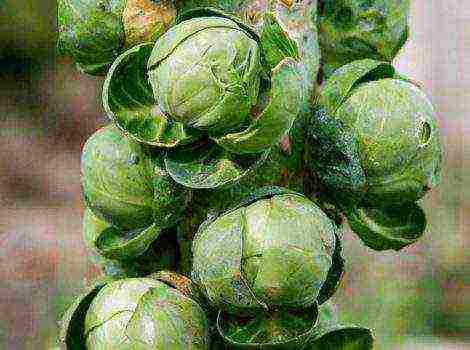Content
 Tulips are very beautiful flowers that are grown for flowering in flower beds and for cutting flowers into bouquets or exclusively for growing bulbs.
Tulips are very beautiful flowers that are grown for flowering in flower beds and for cutting flowers into bouquets or exclusively for growing bulbs.
If you decide to grow these flowers in the country, then the information provided below may be useful to you.
Growing tulips in the country Choosing a site
 When choosing a site for growing tulips, you must take into account that the plant loves humus, light, sandy loam soils... Heavy soils and clean sand soil are not used for planting flowers.
When choosing a site for growing tulips, you must take into account that the plant loves humus, light, sandy loam soils... Heavy soils and clean sand soil are not used for planting flowers.
Tulips grow well in lighted areas, closed from cold and strong winds. Varieties that bloom late are placed in partial shade, where they bloom much longer. In areas that are very shaded in plants, bulbs become smaller. It is necessary to choose non-relief areas, without depressions, moisture often stagnates in these depressions and the bulbs rot out.
There are many indications in the books the need for constant standing groundwater with a well-ventilated topsoil... In Holland, the homeland of tulips, for example, there is a very high amount of groundwater, so that the plant is naturally supported during the growing season.
With very deep groundwater tulip development is delayed and large bulbs, obtained in small quantities. Although in too wet soil with stagnant water, the bulbs can get sick with fungal diseases or, in general, die. In order to reduce the level of standing groundwater, drainage ditches are dug at a depth of 40-50 centimeters.
Soil preparation and fertilization
On clay and loamy soils, which are poorly cultivated for some time before planting tulip bulbs, it is necessary to carry out several activities.
- A large river peso must be mixed into clay soils.
- It is necessary to mix peat, turf soil, humus soil into light sandy soil.
Application of rotten manure, even in small doses, directly under the bulb will lead to the death of the entire tulip root system... The bulbs that have turned out in such areas are completely unsuitable for reproduction. Plowing of green manure and compost has a good effect on the development of bulbs; it must first be disinfected.
After the introduction of manure into the ground, the land is plowed deeply. This type of plowing helps to produce vigorous plants and large bulbs and makes tulips easier to grow.
To prepare the soil in the flower beds, they introduce well-decomposed humus 5–6 months before planting the bulbs.
Planting tulips in the ground
 The best time to plant bulbs is during the fall period from September to October. But much depends on climatic conditions, if the south is later, and the north is later. To correctly determine the timing of planting tulips, you need to know the temperature of the earth... The soil temperature should not be deeper than ten centimeters should be ten degrees Celsius and now you can start planting the bulbs.
The best time to plant bulbs is during the fall period from September to October. But much depends on climatic conditions, if the south is later, and the north is later. To correctly determine the timing of planting tulips, you need to know the temperature of the earth... The soil temperature should not be deeper than ten centimeters should be ten degrees Celsius and now you can start planting the bulbs.
If the soil is still warm, the onion will germinate until the winter cold, and with the onset of spring heat, the flower will not bloom. Late disembarkation is also unpleasant. In this case, the bulb will not have time to start up the roots before frost and the bulb will not be able to take root. It is necessary to follow the weather forecasts.
The autumn planting of tulips gives excellent results: the sprouts are well accepted and bloom for a long time. Still, planting tulips in late February or early March is possible, but less fruitful.
The bulbs planted in the soil, subject to the rules, are very well accepted, the main thing is that the temperature during the day did not fall below ten degrees.
 Why planting in spring is considered not so successful than in autumn. The bulbs planted in spring begin flowering much later than those planted by the summer resident before the winter cold. In order for the culture to germinate quickly, it takes time to cool the bulbs. Only after cooling, a substance begins to form in the bulbs, which is needed for development and a quick start for intensive growth.
Why planting in spring is considered not so successful than in autumn. The bulbs planted in spring begin flowering much later than those planted by the summer resident before the winter cold. In order for the culture to germinate quickly, it takes time to cool the bulbs. Only after cooling, a substance begins to form in the bulbs, which is needed for development and a quick start for intensive growth.
Most often, tulips in the wild begin to sprout immediately after the snow melts. In home greenhouses and flower gardens, growers try to create similar conditions for flowers of cultivated varieties. If, for all sorts of reasons, tulips were not planted in the autumn, planting should be done at the end of March or at the beginning of February. Planting in December is allowed if there is no frost. In this case, it is necessary to cover the bed with dry leaves or spruce branches and cover it with a layer of snow on top so that the bulbs do not freeze.
Planting tulip bulbs in spring can give good results if planting material is placed in the refrigerator several days before planting, wrapped in paper. Then place the tubers for a few minutes with a slightly pink manganese solution. After such events, the flowering period should come faster.
Storing the bulbs
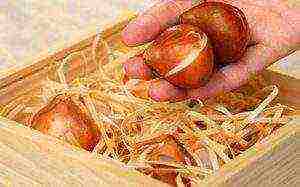 When planning the planting of tulips in the autumn, it is necessary to purchase planting material in the summer and store it correctly until planting. The question arises as to how to preserve the bulbs before planting, it is the main thing for most of the novice florists. As a rule, the acquired tubers are placed loosely in boxes and placed in a cool, dry and dark place. The ideal temperature is considered to be fifteen degrees Celsius.... A cellar or basement will do. The only condition is that the room used should not have high humidity.
When planning the planting of tulips in the autumn, it is necessary to purchase planting material in the summer and store it correctly until planting. The question arises as to how to preserve the bulbs before planting, it is the main thing for most of the novice florists. As a rule, the acquired tubers are placed loosely in boxes and placed in a cool, dry and dark place. The ideal temperature is considered to be fifteen degrees Celsius.... A cellar or basement will do. The only condition is that the room used should not have high humidity.
If you prefer to plant your own tulips that have grown in your garden, follow these steps. In mid-June, you need to dig up the tubers. After that, they should be well dried in an open place with ventilation. At the same time, covering from direct sunlight, otherwise the bulbs will dry out. Further, all the husks are removed from the planting material and the full-fledged children are carefully separated. Placed in a dry, dark and cool place. So, store the tulip tubers before planting.
Successful planting of tulips
We will study how to plant tulip bulbs in the country, at home and in a greenhouse. And how to properly care for them.
When choosing a place you need to consider what plants grew in this place... It is very good if vegetables and flowers grew in this place. And if nightshade or bulbous grew earlier, it is better to choose another site, because there is a high risk of contracting viral diseases. When a place is chosen where the tulips will be planted, preliminary events are carried out. Consisting of the following. In early spring, organic fertilizers are poured into the soil, they decompose slowly. Particularly good fertilizer is manure, rotted or compost.
For planting only healthy and high quality tubers are suitable... You need to carefully examine the bulbs for damage, infection. Selected material, soaked in manganese solution about 30 minutes.
Preparing the beds
 The beds are cut about one meter wide with longitudinal or transverse grooves. The length of the grooves can be any.
The beds are cut about one meter wide with longitudinal or transverse grooves. The length of the grooves can be any.- The nodules are very neatly pressed into the grooves. But at the same time trying not to damage the root system of the bulb... The indentation depth depends on the size of the bulb and on the type of soil. When the soil is light, planting is done deeper, but if the soil is heavy, then the depth is shallower.The distance between the rows is about 20 centimeters, the distance between the tubers is 10 centimeters.
- Sprinkle the tubers on top with a small layer of earth, which is not compressed.
Modern florists tulips are often grown using a tube... This technique gives very good results. To implement the tube technique, it is necessary to take a metal tube with a diameter of 5 centimeters. It should be with a piston that can be fixed, dig out a small hole and place an onion with a tube. The piston pushes it into the ground.
Growing tulips in a greenhouse
 Create the right conditions for planting tulips. It is very easy to arrange this if you make a greenhouse at your dacha. Having a greenhouse, you can breed a crop by the date you need. When growing flowers in a greenhouse, the grower himself creates the necessary humidity, temperature and light levels.
Create the right conditions for planting tulips. It is very easy to arrange this if you make a greenhouse at your dacha. Having a greenhouse, you can breed a crop by the date you need. When growing flowers in a greenhouse, the grower himself creates the necessary humidity, temperature and light levels.
Before planting tulips in the greenhouse, you need to do the preparatory measures:
- Room cleaning: residues and debris of last year's plants. It is necessary to completely disinfect the greenhouse premises.
- Soil preparation... To make the soil fertile, it is reclaimed. The top layer of the soil is removed and the soil is carefully dug up. Shop top dressing, consisting of minerals and earth or soil with humus, is spread in a layer on a dug plane.
- Set the temperature from 15 to 25 degrees Celsius.
- Bulbs are selected for planting... The tubers must be healthy and of good quality. A variety of tulips are available in the shop. Bulbs of about 4-4.5 centimeters are selected. Next, the bulbs are disinfected.
After all the preparatory activities, you can start planting tulips, gently adhering to a distance of one to two centimeters between the grooves. The correct hole depth is four centimeters. Remaining planting process, such as in an open area.
Proper tulip care
 With the arrival of spring heat, it is time to care for the tulips that grow in the open field, the first shoots appear. All bulbs that have not sprouted need to be dug up, because they can disappear and infect healthy tubers. When buds form and bloom, they are watered abundantly and often. Irrigation is a very important part of maintenance. Water abundantly for 15 days and until the end of the flowering period.
With the arrival of spring heat, it is time to care for the tulips that grow in the open field, the first shoots appear. All bulbs that have not sprouted need to be dug up, because they can disappear and infect healthy tubers. When buds form and bloom, they are watered abundantly and often. Irrigation is a very important part of maintenance. Water abundantly for 15 days and until the end of the flowering period.
The soil needs to be loosened or weeded... This will keep the moisture in for longer. All weeds must be pulled out in time. Weeds drain the land and can infect tulips with fungal diseases. The buds that have wilted must be cut off. It is absolutely impossible to cut the leaves. The more and longer the greenery remains on the plant, the more the bulb will receive nutrients and nutrients.
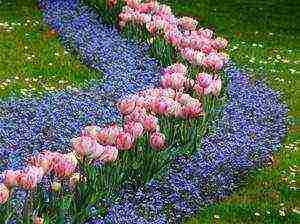 Tulips can be seen in parks, on window sills, summer cottages, and even in city apartments. It is a flower that symbolizes spring and femininity. Possessing extraordinary beauty and unpretentious care. Of course, in order to get a beautiful flowering plant, you need to know the rules for choosing and planting bulbs and caring for them. This article provides a few guidelines. And following them, breeding and planting will not be difficult for you and will certainly meet your expectations.
Tulips can be seen in parks, on window sills, summer cottages, and even in city apartments. It is a flower that symbolizes spring and femininity. Possessing extraordinary beauty and unpretentious care. Of course, in order to get a beautiful flowering plant, you need to know the rules for choosing and planting bulbs and caring for them. This article provides a few guidelines. And following them, breeding and planting will not be difficult for you and will certainly meet your expectations.
 What you need to know to grow tulips in the country?
What you need to know to grow tulips in the country?
Tulips occupy an honorable place in the lily plant family. These charming flowers are frequent guests at various holidays, city streets and summer cottages. The aroma and beauty of tulips makes a lot of people feel better. The huge variety is of particular interest. In this regard, many people are interested in planting, caring for and growing tulips.

During growth and flowering, tulips need abundant watering and fertilizing with mineral fertilizers.
Back to the table of contents
Existing tulip varieties
Today there are a large number of tulip varieties.Among summer residents, the cultivation of the Cardinal variety is widespread, which is distinguished by the brightness of pink and red shades. Due to its early flowering, this variety is often used in the event of spring holidays.
There are also terry tulips. The most common variety in this case is "Murillo". These flowers most often delight with their dazzling whiteness with a pink tint. Murillo contains many petals in the bud, which adds more charm and interest to it.
The varieties "Triumph" or "Telescope" can please with a pleasant and harmonious combination of colors and shades. They are distinguished by their high height (50 cm).
There are also green-flowered tulips, parrot, fringed and others.
Back to the table of contents
How is tulips planting and growing in the country? 
Greenhouse scheme for flowers.
Each of the varieties has its own distinctive characteristics. However, there are signs that are suitable for almost all representatives.
Tulips are flowers with an erect stem, the height of which is 20-90 cm. The leaves are most often smooth or wavy in shape, have a pale green color. Tulip flowers in most cases have the shape of bells or funnels of a wide variety of shades (even black). The flower fruit is a box with ripening flat seeds inside.
Growing tulips in the country should start with choosing good, healthy bulbs of the same size. It is recommended to buy seed and fertilizer from reputable organizations. It is worth noting that the size of tulip bulbs is an excellent indicator of variety and quality.
The next step is to choose the place that is most suitable for planting these dainty flowers. Such flowers love moisture and sandy loam light soil. In addition, the landing site must be reliably protected from cold winds.
Tulips are a perennial plant. However, it is not recommended to grow them in one place for more than 4 years. The first time you need to plant these flowers in place of onions, cucumbers or asters.
Back to the table of contents
Necessary conditions for growing flowers in summer cottages 
Before planting tulips, it is advisable to fertilize the soil for better root development.
Around the end of August or the beginning of autumn, you will need to carefully dig up the site that was planned for planting. In the process, it is necessary to apply mineral fertilizers. The best option is potash salt (about 40-50 g per 1 m²) and potassium magnesium (80-90 g per 1 m²). It is recommended to complete all preparatory work with the soil a week before planting.
The most optimal time for planting tulips is the autumn period of time (late September-early October). However, one should not forget about the weather and the recommendations for growing the particular variety that has been chosen. Most often, the optimum soil temperature for good root development is 6-8 ° C.
Before planting tulips, the bulbs must be peeled, then inspected the appearance and integrity, soak for half an hour in a solution of potassium permanganate.
Bulbs with suspected diseases or other disorders will need to be immediately separated from the general mass: they sit in a different place.
Immediately after the prevention has been carried out, the bulbs must be planted in the holes. It is imperative to pour a 2-3 cm layer of sand into each of them. Then they are gently pressed down with their bottom. The bulbs will need to be sprinkled with wood ash, a final layer of soil and a layer of sand.
Planting depth will directly depend on the size of the bulbs. In this case, there is a simple rule: after burying, a layer of soil should remain above the bulb, which is equal to 3 bulbs in height. Accordingly, it is quite easy to determine the exact location.
The planting density will also depend on the size of the bulbs. Large specimens will need approximately 50 per 1 m², and small ones - from 75 or more.Most often, tulips are planted across the garden in rows with a distance of approximately 20 cm.
If tulips are planted in sunny, dry weather, the garden will need to be watered well beforehand.
Back to the table of contents
What kind of care is needed for tulips in the country? 
A sunny place protected from strong winds is suitable for tulips in the garden. The soil is desirable loose, crumbly, preferably sandy. Acidic soils are suitable only after liming.
The main component of caring for such graceful flowers is watering, the frequency of which will directly depend on weather conditions and the degree of moisture in the area.
The maximum amount of water you need will need to be used during the flowering period. If there is no rain, then 1 m² may need several buckets of water. Depending on the variety, tulips need to be watered after flowering for several weeks.
Be sure to take care of the tulips before the winter period. It is advisable to fill the beds with compost, straw or peat with the onset of frost. Such mulching can not only create an optimal atmosphere for the bulbs, but also close access to most parasites.
Back to the table of contents
Existing diseases and parasites
Everyone knows that not only people like graceful flowers. There are many diseases and pests of flowers of this kind. The most unpleasant of these is the infectious nature of most diseases. Some of them should be considered, as well as possible ways to combat these diseases.
Gray mold, which is quite common. Its main symptoms: browning or darkening of all parts of the plant. There is a possibility of root or stem rot. In this case, a gray bloom may form on the petals of the flowers.
To combat gray rot, you will need to plow the land, and then add a product that is recommended for a particular tulip variety. Preventive measures include adherence to deadlines, proper storage and maintenance of bulbs.
Fusarium. After the spring snow has completely melted, fusarium can appear, which can be determined by the massive rotting of young shoots. Multi-colored rot with a strong odor can form on the bulbs. This disease causes the fungus Fusarium in tulips.
The main methods of combating fusarium are the removal of the affected parts of the plant, disinfection of the soil using the thermal method. The soil can be fertilized with water (1 l) with ammonium carbonate (100 g), and copper sulfate (10 g), which must be dissolved in water.
3) Onion root mite. The most common insect pest is this mite. It can be identified by withering yellowing leaves and a strong suspension of growth of these flowers.
With such a mite, you must begin to fight immediately. For example, you can steam the soil. This type of tick is afraid of onion husk infusion. To prepare it, you will need about 8 g of husk and 1 liter of water. It should be insisted for about 5 days.
Spraying tulips is not excluded during the growth process. This method will protect plants well from various infections.
It is necessary to use products that are suitable for a specific tulip variety, for example fentiura. It is necessary to make sure that the agent gets into both the underground and aboveground parts of the plants.
Back to the table of contents
Bulb digging process
After the spiritual enjoyment of the flowering of these flowers, you need to prepare for their early digging. You should not wait until they dry up. Digging time can be determined by yellowing stems. Each bulb will need to be carefully removed and cleaned of excess soil.
Tulip bulbs need to be sorted by variety: for example, in plastic boxes with a mesh bottom. Then they will need to be kept under a canopy for several days.It is recommended to dry flowers in a room that has good ventilation, while taking into account the temperature regime.
A shed or other dark room is best for storing the bulbs properly. The bulbs should be checked from time to time for any defects or diseases. Under optimal growth conditions and proper storage, these flowers will delight you with their beautiful flowering more than once.
Tulips are gorgeous flowers that need some attention. However, at the same time, they are able to satisfy human needs for beauty and brightness.
Tulips are grown in greenhouses, open field and containers. They are used as decorative elements to decorate flower beds, balconies, they are used to make bouquets. The country that is famous for the cultivation of these beautiful flowers is Holland.
The content of the article

These perennial bulbous plants, which belong to the lily family, were brought from Central Asia in the XIV century. They are unpretentious when breeding, they love warmth and light. Currently, about 110 species of these plants are known, and it is impossible to even count the varieties. Varieties differ in the shape of the flower and petals, in the color of the bud.
The stem of a plant can reach a meter in height, it is erect, cylindrical in shape. The leaves are lanceolate-elongated, green with a bluish tinge, they have a waxy coating. Each plant has a separate flower - with the exception of a few varieties, it is bisexual, perianth 6 loose leaves, 6 stamens.
Most of the naturally occurring colors come in 3 colors: yellow, red, white. Thanks to selection, even green tulips have been obtained.
The shape of the inflorescence can be:
- star-shaped;
- goblet;
- fringed;
- oval;
- cupped;
- terry.
Bulbs are oval in shape, small can be flattened. They serve for vegetative propagation. If you look at the bulb, you will notice that it is a bottom, which is an underground shoot of a plant, with fleshy leaves of a modified form.
The root system goes deep into the soil up to half a meter, it is sufficiently developed. The fruit is a trihedral box, it contains a lot of seeds.
You can plant tulips in the country for your own pleasure and for sale. This process is not expensive, the cultivation of these plants does not require special care.
For planting tulips, you should choose a well-lit place in a summer cottage with drained soil. Only you can not plant flowers where onions and nightshades used to be planted. For later varieties, there should be more shade, otherwise they will bloom early.
It is imperative that the landing area be protected from northerly and easterly winds.
The culture prefers a slightly alkaline, sandy loam soil, therefore, in the presence of clay, river sand should be added to it. In addition, when arranging a bed, an additional 2 cm layer of sand is placed in it at the bottom of the furrow before planting the bulbs.
The fertile layer should be at least 30 cm.
How and when is it better to plant tulips in the country? It is preferable to do this in the fall. It is best to plant the bulbs in September, keeping the air temperature around 10-15ºC.
The depth of the hole is important - it should be about 3 bulb sizes in height.
Shallow planting - the plant can freeze until spring, very deep - the variety degenerates, the flowers are crushed.
Some growers, in order not to risk it, plant tulips in the spring.
Before planting the bulbs, it is advisable to process them with a strong solution of manganese or foundation. They need to be placed in manganese for 2 hours, in fundanazole - for 25 minutes.
Furrows should be separated from each other by a distance of 20 cm. Their direction is from west to east. It is necessary to leave a gap of 10-20 cm between the bulbs in the furrow, depending on the size. The bottom is directed downward.
Fertilization is required before planting flowers.
Of the ready-made, we can recommend:
- biotone;
- kemira wagon;
- konevitis.
Manure and compost contribute to the enlargement of flowers, only the compost should be well reprocessed. Fertilizing the crop is carried out only in wet soil, after rain or watering.

As soon as the budding of plants has begun, special attention will have to be paid to watering. It is impossible to fill the flowers, the root system will immediately begin to rot.
Watering is carried out once a week - 10 days, depending on natural weather conditions.
Mulch is not removed from the soil, only spruce branches are removed, and then if early varieties were planted in autumn.
The first feeding is done only after the sprouts appear. It depends on what the soil was fertilized with when planting in the fall. For example, superphosphate was added in the fall. It is no longer required to add it in the spring. The choice of the soil is fed with ammonium nitrate, urea 0.15%, nitrophos or ammonium sulfate 0.2-0.25%.
The second feeding is carried out taking into account the previous one during budding.
If tulips were planted in spring, then it is better to feed them with slurry, bird droppings, go mullein.
Arid soils require additional boron and zinc.
They also take care of flowers during the flowering period. If it was not planned to cut them off, then it is not recommended to wait for the petals to fall off on their own. The bud must be plucked as soon as the flower begins to fade, otherwise pathogenic flora will invade the fallen petals and the bed will be infected.
It is important to know not only how to grow tulips and take care of them in the country, the "harvest" must also be harvested correctly.
Cut flowers at the stage of a colored bud either in the early morning or in the evening. Leaves must remain on the stem - at least 2. After cutting tulips, the tool is always treated with a solution of soda or manganese for disinfection purposes.
If you dig up the bulbs every year, the planting material will be of high quality. It is very important to know the exact digging time.
This is determined in the case of early varieties by the following signs: the leaves have turned yellow, the scales of the bulb have become light brown. When working with late varieties: the top of the stem softens, the leaves are just beginning to turn yellow, the bulb turns brown.
First, the early varieties are dug up, then the later ones. The bulbs are immediately brought into a closed place, cleaned of soil and scales. In the first 30-40 days after harvesting the bulbs, the storage temperature should not be higher than 25ºC and below 22ºC, then it is very important to keep them at a temperature of 15 to 18ºC for a week. The storage temperature is then reduced to 12ºC.
It is not recommended to mix varieties during storage. There should be no moisture in the storage, but they will not survive in dry air. The approximate humidity in the room needs to be maintained at about 70%.

If tulips have to be grown in the open field, then in the country this can be done every 2 years, but not less often, otherwise the variety will begin to degenerate. But the bulbs remaining in the soil must be sprinkled with spruce branches or cartoons, otherwise they will freeze over the winter.
As soon as the overwintered bulbs begin to germinate in the spring, it is required to immediately loosen the soil around them. After heavy rains, the tulip rosette must be raised above the ground, loosening the soil and forming a circular earthen parapet in order to prevent the plant from rotting.
Usually, experienced gardeners for this purpose lay decorative strips of stones along a row of tulips. This helps keep the flowers from rotting and creates a unique flower bed design. In the spring, tulips at the dacha make the garden luxurious.
Video: Grow tulips: tips and tricks

Turkey is the first country to cultivate wild tulips. Back in the 16th century, the selection of the most beautiful wild-growing flowers for breeding garden varieties of plants began here.
These flowers were named tulips for their resemblance to oriental headdresses - turbans.A century later, having found themselves in Holland, now known as their second homeland, the beautiful flowers gradually spread to many countries of the world.
They came to Russia in the era of Peter the Great. Nowadays, thanks to the selection and hybridization of wild plant species, there are a great many (about 2000) varieties of garden tulips of various colors, shapes, sizes and even flowering periods.
But subject to the simple general rules for caring for flowers, even the most modest of them will decorate any corner of the garden.
Growing methods

Growing a tulip from a bulb is the easiest method
There are three known methods of growing garden tulips: from seeds, from a bulb and from "babies".
- The method of growing from seeds is complex and painstaking. A faded flower arrow is tied up and seeds are waiting for the seeds to ripen on it. They are then harvested and stored in a dry and dark place until sowing in the garden in September-October. Densely sown seeds are carefully covered with earth. They usually germinate after the snow melts. Bulb formation takes place in several stages, starting with the appearance of a single leaf. In the spring of the fourth year, the ready-made onion is dug up, laying it on a summer drying. In the fall, it is planted again, waiting for another year or two to obtain the full color of the flower.
- The easiest way to grow is from a bulb. Its quality is critical. The bulb should be intact and firm. It is better to choose at least three centimeter bulbs for planting. They are planted in three pieces in a mixture consisting of three parts of sand, as many - earth and four parts of humus. Bulbs that do not touch each other should not be completely buried in the ground. Plants will not freeze and hatch if the air temperature is kept at 12 degrees Celsius. Water them with settled water.
- Small bulbs are called "babies" in tulips. They rarely get sick, because are not damaged when disembarking. In this case, the planting depth should be at least three bulbs in height. Trenches with planted plants are fed with humus or manure. In the spring of the first year, the soil is loosened three times, weeding, and plant feeding. If the soil is clay, then in order to avoid rotting of the bulb, it has to be dug out in the fall until next spring. Therefore, sandy soil is preferable for these plants, in this case the young bulb overwinters in the flower bed. In the spring of next year, the large "children" finally have flowers. This method of growing bulbs is the best for large arrays of flowers, because at the same time significantly saves money on the purchase of planting material.
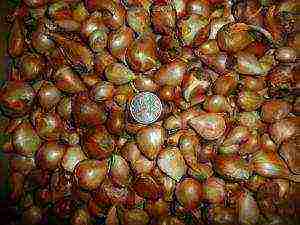
"Babies" of tulips - small bulbs
The technology of growing tulips from a bulb in a garden plot
Tulips do not require complex care, they are very unpretentious, but in order to grow beautiful and large flowers, you must follow a number of rules common to all plant varieties:
- In early spring (the snow has not melted yet), it is necessary to start feeding them with fertilizers used for garden flowers, in the amount of one and a half to two and a half dozen grams per square meter of the garden. The next feeding takes place during the budding of flowers, and the last one - after their flowering.
- The appearance of plants determines which nutrient deficiencies they are experiencing. For example, with a lack of nitrogen, its leaves become narrow and slope. At the same time, the color of the stems and leaves changes to reddish. A deficiency of potassium and phosphorus is manifested by the appearance of a bluish border along the edges of the leaf.
-

In the spring, you need to fertilize tulips.
In the spring, it is necessary to completely remove diseased plants, while capturing the adjacent soil. This place is disinfected with a very hot solution of potassium permanganate.
- When loosening, weeding, feeding and other methods of caring for plants, you should be careful not to hurt their leaves and roots, without which the formation of a healthy bulb is impossible.
- For the successful establishment of daughter bulbs, it is important to maintain constant soil moisture by regularly watering it from the beginning of budding of the plant, finishing it only a couple of weeks after all flowers have bloomed.
- In order to prevent the appearance of "children", after flowering, the flowers are torn off by hand, leaving a part of the leaves to feed the bulb.
- Tulips prefer light, drained soil. The bulbs should be dug up annually. But with their deep planting and sufficient plant feeding during the entire growing season, transplantation can be carried out every three years.
- When transplanting in early summer, the bulbs should be dug up and dried to avoid fungal diseases. This should be done in a shady, well-ventilated place. And you need to store planting material until autumn in boxes, providing them with a label indicating the variety of the plant.
-

In winter, tulips need to be protected from frost.
In early autumn, tulips can be planted in the ground. Trenches up to three tens of centimeters wide and up to two tens of centimeters deep are fertilized with superphosphate. Disembarkation begins with large specimens, placed bottom down. They are sprinkled with earth a little. In the intervals between the first layer of plants, smaller specimens are planted, also sprinkling them. At the end, the "kids" are placed, and the trench is covered with the remains of the earth.
- In a frosty winter with little snow, when the temperature in the soil even at a depth of two tens of centimeters can reach minus 9 degrees, you should cover the tulip areas with humus, sawdust or straw with a layer of at least ten centimeters. Otherwise, there is a risk of deformed flowers appearing from the frozen bulbs.
- Tulips can grow successfully after any flowers and vegetables. It is advisable only not to plant them in places where bulbous and nightshade plants previously grew. Flowers love sunny areas protected from cold winds. If the lighting of the bed is insufficient, then there is an enhanced stretching of the stem to the detriment of the development of the bulb. And this leads to the crushing of flowers. This requirement applies to early tulip varieties. Their later varieties, in order to prolong their flowering, are best planted in partial shade.
Plant digging technology
There is no consensus among flower growers about the need for an annual digging of tulips. This process definitely contributes to the high quality of the bulbs, however, it is troublesome and time consuming.

It is better to dig up tulip bulbs every few years.
Therefore, everyone decides for himself whether it is worth digging out the plants every year, or to do it at intervals of a couple of years, while providing additional care for the bulbs wintering in the soil.
Those who consider it necessary to dig up tulips every summer should heed a few tips on this matter:
- Digging ahead of time threatens with underdevelopment of the bulbs, and, therefore, affects the quality of the flowers. If the dates are delayed, losses in the number of bulbs are possible. The signal to start digging early varieties of tulips is their completely yellowed leaves. The optimal time for digging up late varieties is the beginning of yellowing of the leaves. During this time, the bulbs turn light brown and the tops of the stems are soft. This happens for different plant varieties from the end of May to the end of June.
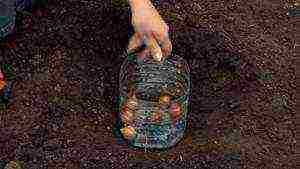
Conveniently store bulbs in a plastic bottle with holes
- Digging should be done on a dry sunny day, while loosening the ground well.
- The bulbs are dried for several days in a warm, shaded place. Then they are cleaned of soil and plant debris, while checking their integrity.
- Planting material is sorted, separating large specimens from medium and small ones.
- If the tulips were planted in five-liter plastic bottles with holes previously made at the bottom and a soil mixture laid there, then their digging becomes easier.The container with these plants, removed from the ground immediately after the flowering of the peduncle, is transferred to the storage location. Here, continuing the usual care for them, the bulbs are waiting for the ripening.
- When planting bulbs in small-mesh baskets, when digging these containers, take into account that small planting specimens, penetrating through the cell, can emerge below the level of the bottom of the basket. Therefore, it must be dug up along with the adjacent soil.
- The digging process must be completed by plowing and fertilizing the soil, preparing it for the subsequent planting of plants.
Enemies of plants - diseases and pests
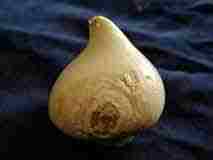
Fusarium tulip, damaged bulb
Tulip bulbs are susceptible to various diseases spreading due to their mechanical damage or with the help of garden pests such as ticks, bear, beetles and others.
If the upper part of the plant turns yellow, dries up, and the bulb dries, darkens, germinates with spores, or rots and completely disappears, then the plant is affected by fusarium or penicillous rot.
When a plant damages an onion mite, causing bacteriosis, the bulbs turn brown and rot, emitting a foul odor.
The manifestation of unusual decorativeness on flowers in the form of various spots, specks, stripes, veins is a symptom of a very common and dangerous viral disease - "variegation". It is characterized by damage to the plant as a whole with changes in its metabolic processes.
To avoid spreading the infection to the entire flower area, all diseased plants should be immediately destroyed.
Garden tulips are one of the most common flowering plants, known for their beauty, diversity and unpretentiousness:
-

Tulips on the site are very beautiful
most often they are grown from bulbs;
- these spring plants thrive in sunny places with regular watering;
- they prefer light soils with a significant sand content;
- tulips need feeding three times a day;
- an important role for the size, beauty and yield of flowers is played by proper bulb care;
- flower growers disagree about the frequency of digging up plants, which affects some of the features of agricultural techniques used in the practice of cultivating tulips.
Flowers of incredible beauty - yellow, white, red, orange and other flowers in color - give joy to those who receive a colorful bouquet as a gift, and reward all the efforts of an amateur gardener.
